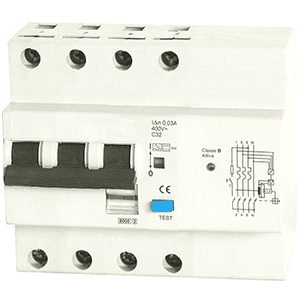Type B RCBOs 3P+N 30mA Residual Current Circuit Breakers
RCBOs type B grant protection to persons and machineries in presence of DC current and high frequency AC fault current. Among the several types of RCBOs, type B provide the upmost level of protection.
Some applications’ examples are: electrical installations protecting elevators, escalators, welding machines, electro-medicals’ instrumentation, ventilation systems, PV systems, e-mobility charging stations.
For more information about technical characteristics, applications and Standard references concerning type B RCBOs.
RCBOs’ mechanism is trip-free, that is the RCBOs can also trip when the lever is held in ON position.
All RCBOs are equipped with a visual indicator which discriminates residual current tripping (blue) from overload tripping (transparent) and with a green led signaling that the voltage is sufficient for product’s functioning as type B.
All products must be power supplied from the power side. Furthermore “cage” type terminals facilitate connection both through conductors (up to 35 mm² rigid and 25mm² flexible) and through busbars (both pin or fork types).

The use of electronic equipment (e.g. frequency converters) in electrical installations is constantly increasing. In the event of a fault smooth DC currents and high frequency AC residual currents may arise; these will not be detected by a standard type A residual current protection device. This is the reason type B, residual current protection devices, should be used especially for such applications.
Examples of applications are elevators, escalators, ventilation systems, pump controls, welding equipment, building sites’ power distributions, industrial washing machines, medical-technical applications (X-ray equipment, MRT), in shopping centers, industry, agricultural workshops, sewage works.
Italclem’s range includes AC-DC sensitive RCCBs and RCBOs for DIN rail mounting which are in compliance respectively with VDE 0664 Part 10 and 100, and VDE 0664 Part 20 and 200. These items have two different characteristics of the tripping frequency course:
NK version: devices with the NK suffix are specially designed for use in electrical installations where reliable fire protection over a wide frequency range is required. These items are in compliance with the requirements of VdS Directive 3501 in respect of fire protection up to 100kHz (within the range of the switching frequency converters).
SK version: devices with the SK suffix are suitable for applications in electrical installations where particularly high leakage currents within the range of the switching frequency of frequency converters are to be expected and no fire protection is demanded. Due to an increased insensitivity in the upper frequency range, unwanted tripping can largely be avoided.
Applications
In the industrial, tertiary and hospital sectors applications where residual current devices type B are required are more and more common.
In case of failure to earth, three-phase systems and equipment of class I including electronic circuits can generate DC fault residual currents or high frequency, which cannot be detected by type A or type AC residual current circuit breakers.
The main categories of these systems and equipment are:
Three-phase static continuity systems (UPS) (hospitals, shopping malls, banks, laboratories, industrial plants);
Frequency converters (inverters) for the supply of DC current motors (elevators, tooling machineries, robotics, transfer lines, circulation pumps, centrifugal pumps, conveyors, mixers, textile machines, packaging machineries). Three-phase frequency converters (inverters) are more and more used to regulate motors as they grant more efficiency and energy savings. In case of earth fault, they may cause smooth DC currents or high frequency. This fault can be protected only by type B RCCBs or RCBOs. Regarding the type of traction, elevators can be electric with ropes or hydraulic. Electric elevators are recently manufactured with speed control systems based on frequency and tension’s variation of asyncron three-phase motors by mean of inverters.
AC and DC converters for DC current supply (elevators, tooling machineries, extruders for plastics, lifting systems, presses, dies, welding machineries, railway traction, magnetic resonance, X-ray instrumentation); class I converters are made with a three-phase bridge arranged with six diodes or with six thyristores, therefore they must be protected by a RCCB or RCBOs type B.
AC and DC converters for the conversion of the energy provided by PV systems into AC current (PV systems with a static converter without transformer). When an electrical installation includes a PV supply system without at least a simple separation between AC and DC side, the residual current device to be installed as protection against indirect contacts must be type B. Instead, type B RCCBs/RCBOs are not compulsory if the inverter is, by construction, structured to block DC faults currents to earth. In this case the inverter’s manufacturer must provide relevant Declaration.
Charging stations for electrical vehicles, with three-phase supply system. The chargers mounted on electrical vehicles contain non linear parts and filters suitable to generate currents to earth containing DC current.
Post time: Jun-07-2020
